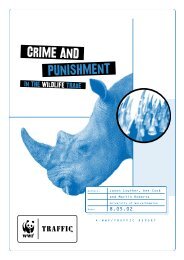Deeper Luxury Report - WWF UK
Deeper Luxury Report - WWF UK
Deeper Luxury Report - WWF UK
Create successful ePaper yourself
Turn your PDF publications into a flip-book with our unique Google optimized e-Paper software.
Newsweek, the appearance of Armani t-shirts, Prada<br />
bikinis and phones, and Versace sofas and hotels, have<br />
caused luxury to “lose its cachet”. As family-owned<br />
luxury companies have given way to large conglomerates,<br />
so the industry has “sacrificed its integrity, undermined<br />
its products, tarnished its history and hoodwinked its<br />
consumers,” says Thomas. 45<br />
A fashion expert in the<br />
New York Times agreed that, whereas luxury brands<br />
were “once guarantors of value and integrity”, they are<br />
now “markers that point toward nothing, guiding the<br />
consumer on a road to nowhere”. 46<br />
There is also a<br />
concern that private equity firms may compound the<br />
problem by treating their newly-acquired luxury<br />
subsidiaries as cash cows. 47<br />
Brands may restore lost cachet by imbuing their products<br />
and services – and, indeed, the brands themselves –<br />
with deeper meanings and values, embodied in the<br />
concept of sustainability.<br />
Furthermore, the emergence of the internet has weakened<br />
the ability of companies to control the identities of their<br />
own brands, and enabled consumers to start setting<br />
their own trends. Since the 19th century, luxury fashion<br />
houses have led fashion, but now trendsetters are drawn<br />
from many social groups. 48<br />
“There is now a two-way<br />
dialogue and an unfettered exchange of opinions,<br />
reviews and information”, says Brand Channel, and<br />
“this apparent rise of people power is making the luxury<br />
brands baulk; they are scared that they may lose control<br />
of their brand”. 49<br />
Joe Chung, chief executive of innovative<br />
e-commerce software provider Allurent, agrees: “Like<br />
it or not, all brands are losing control... everyone is<br />
influenced by blogs.” Looking at fashion trends among<br />
those most using digital social networking gives us<br />
insight to the future: “Young people are more comfortable<br />
with a peer-to-peer viewpoint, so they are more likely<br />
to see a few Japanese designers as equally [sic] good<br />
as Western ones,” explains Japanese consumer expert<br />
Michael Causton. 50<br />
The world’s wealthiest consumers<br />
are now using the web’s interactive capabilities, and<br />
expect to purchase luxury goods online. 51<br />
The internet also prevents brand owners from presenting<br />
inconsistent images across geographical markets, since<br />
national governments are unable to effectively restrict<br />
the surfing habits of consumers. 52<br />
Therefore, a new<br />
paradigm for both brand communications and design<br />
innovation is required. This will invite consumers to<br />
participate in the creative process within a framework<br />
of global core brand concepts. In this way, real<br />
communities will grow around the brands. A brand<br />
will no longer grow because of how well it is controlled,<br />
but because of how well it is shared. Of paramount<br />
importance will be the way in which a brand’s traditions<br />
and practices relate to contemporary concerns such<br />
as wellbeing, work-life balance, community security and<br />
environmental protection. Therefore, a brand’s social<br />
and environmental depth will become an important<br />
determinant of its financial value.<br />
Challenge 3: The casual consumer<br />
The demographic of the luxury consumer is broadening:<br />
younger people in the West have begun consuming<br />
luxury brands; brands have expanded into new markets,<br />
where the population is generally younger; and, at the<br />
other end of the age scale, “baby boomers” are spending<br />
their considerable wealth in retirement on luxury goods<br />
and services. All of these factors have led to a more<br />
casual trend in luxury fashions. Diesel’s Renzo Rosso<br />
says that the young luxury is casual, not stiff. This poses<br />
a challenge to luxury brands, since luxury t-shirts cannot<br />
justify margins of the type available to purveyors of<br />
Savile Row suits. 53<br />
Superior social and environmental<br />
quality could be a justification for their higher prices<br />
and will afford the opportunity for higher margins.<br />
Challenge 4: Western existentialism<br />
As brands lengthen their presence in the market,<br />
so the interests of luxury consumers mature. Industry<br />
specialists are agreed that in the West, this maturing<br />
process involves a form of post-materialism and an<br />
emphasis on experience. (This is illustrated by the<br />
growth in health spas, holidays and the like.) 54<br />
<strong>Luxury</strong><br />
lifestyles are increasingly understood to avoid favouring<br />
such experiences over mere “stuff”, which is perceived<br />
as “clutter”. 55<br />
There is some uncertainty about what<br />
kind of experiences people are seeking. Some stress<br />
individualistic needs for personal attention and<br />
excitement. 56<br />
Others suggest that people seek what they<br />
<strong>Deeper</strong> <strong>Luxury</strong><br />
18/19


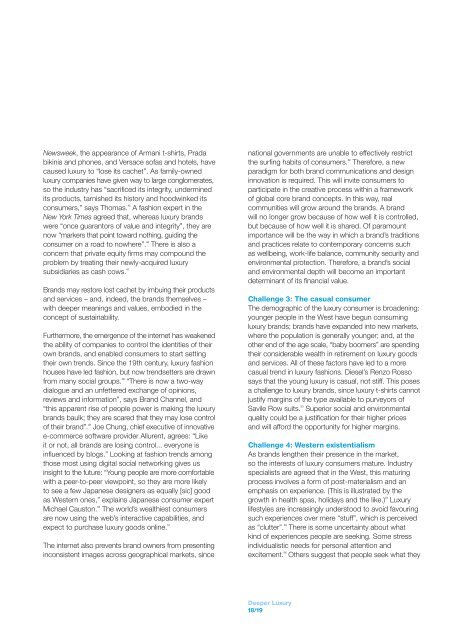


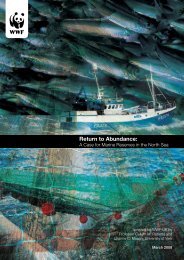




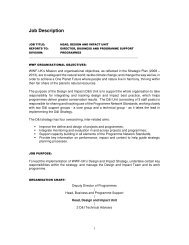



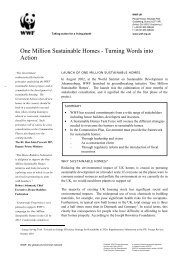
![[PDF] Causes for concern: chemicals and wildlife - WWF UK](https://img.yumpu.com/31929970/1/184x260/pdf-causes-for-concern-chemicals-and-wildlife-wwf-uk.jpg?quality=85)
